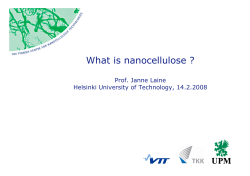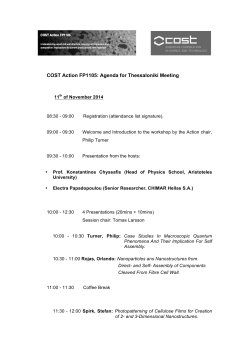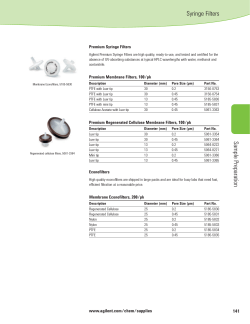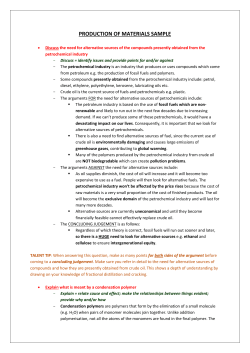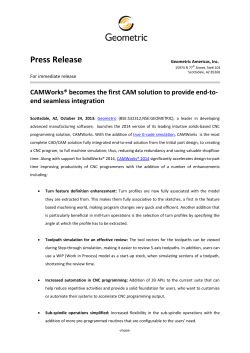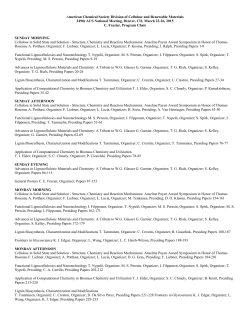
Safety Data Sheet - American Process Inc.
BioPlus™ Crytals
1. CHEMICAL PRODUCT AND COMPANY INFORMATION
NOTE: This Safety Data Sheet is for informational purposes only, and represents a preliminary assessment for a new
pre-commercial substance that has not been tested in safety evaluations. The information provided is based on the
best available published and unpublished data for similar substances, as listed below.
1.1 Product identifiers
Product name: BioPlus™ Crystals
Other common names or synonyms: cellulose nanocrystals, nanocrystalline cellulose, whiskers, crystallites, rodlike
cellulose microcrystals, cellulose nano-spheres
REACH no.: At present, REACH does not require registration of cellulose nanomaterials. Cellulose pulp is exempt from
obligations to register under REACH (Article 2(7)(a) - Annex IV).
CAS no: Cellulose (9004-34-6) (manufactured nanocrystalline form)
1.2 Supplier details
Company:
Address:
American Process, Inc.
750 Piedmont Ave. NE
Atlanta, GA 30308
Phone number: 404-872-8807
Fax:
404-876-6704
Emergency phone number:
CHEMTREC (24hr Emergency Telephone) 1-800-424-9300;
International CHEMTREC 1-703-527-3887
1.3 Product use: Recommended use: Manufacture of substances, Laboratory chemicals
2. HAZARD IDENTIFICATION
NOTE: The hazardous properties of this substance have not been evaluated. The classifications are based on available
information for materials of similar chemistry.
2.1 Hazard classification
Acute toxicity: If dry, possible Category 5.
2.4 Precautionary statements
If dry, keep away from all ignition sources including heat,
sparks and flame. Prevent dust accumulations to minimize
explosion hazard.
2.2 Signal word
Warning
2.5 Other hazards
Explosion hazard: Dry particles may form combustible
dust in air at high concentrations.
2.3 Hazard statement(s)
If dry, may be harmful if inhaled.
3. COMPOSITION AND INGREDIENT INFORMATION
Chemical name: Cellulose Nanocrystals CNC (BioPlus™
Crystals)
Common name and synonyms: cellulose nanocrystals, nanocrystalline cellulose, whiskers, crystallites, rodlike cellulose
microcrystals, cellulose nano-spheres
CAS-No.: Cellulose (9004-34-6) (manufactured nanocrystalline form)
Composition: Gel – 7% CNC, ~93% water; Powder – 100% CNC
BioPlus™ Crytals
4. FIRST-AID MEASURES
4.1 First aid measures
Inhalation
Skin contact
Eye contact
Ingestion
4.2 Most important symptoms or
effects
Acute effects
4.3 Recommendations for immediate
medical care and special treatment
Delayed effects
Note to
physician
If dry powder, move to fresh air. Get medical attention if
symptoms appear.
Soap wash. Get medical attention if irritation occurs.
Remove any contact lenses. Irrigate immediately. Get medical
attention if irritation occurs.
Do not induce vomiting unless directed to do so by medical
personnel. Get medical attention if symptoms appear.
Potential symptoms: (based on cellulose powders) irritation of
eyes, skin, mucous membranes. Hoarseness, cough and phlegm.
Exercise-induced dyspnea.
No data available.
This product may contain nanoscale particles. At this time, there
is no further guidance specific to nanomaterial exposure.
5. FIRE-FIGHTING MEASURES
5.1 Suitable and non-suitable
extinguishing equipment
5.2 Hazards arising from
substance or mixture
5.3 Special protective equipment
or precautions for fire fighters
Use water, alcohol-resistant foam, dry chemical, or carbon dioxide.
Explosion: Avoid generating dust; dispersed dust in air at sufficient concentrations
and in the presence of an ignition source can create a severe explosion hazard.
Manufactured nanoforms, particularly powders, might show unusually high reactivity,
especially for fire, explosion and catalytic reactions, when compared with equivalent
materials with larger particle sizes.
As in any fire, wear self-contained breathing apparatus pressure-demand,
MSHA/NIOSH (approved or equivalent) and full protective clothing.
6. ACCIDENTAL RELEASE MEASURES
6.1 Personal
precautions and
protective
equipment
6.2 Cleanup
procedures
For dry powders, remove any ignition sources and provide sufficient ventilation. Avoid dispersal of
dust in the air (i.e., clearing dust surfaces with compressed air). No current guidelines available for
nanoscale materials. Use current good practices. Wear full set of protective clothing and contained
breathing apparatus for spills of solid material. Avoid inhalation of spilled powders, and avoid dermal
contact with nano powders and solutions. See section 8.3 for more details on protective equipment.
For dry powders, ensure the product is not present at a concentration level above cellulose TLV (see
section 8.1). Use HEPA-filtered vacuum cleaner or wet wiping methods and avoid re-dispersion of
nanomaterial into the air. Clean liquid spills with absorbent materials/liquid traps. Immediately dispose
of cleaning materials and do not dry and re-use contaminated materials.
7. HANDLING AND STORAGE
7.1 Precautions
for handling
7.2
Recommendations
Use exhaust ventilation system with HEPA filter when handling nanomaterials in powder state. See
section 8.3 for recommended personal protective measures. The same precautions taken for handling
and storage of dusts and fine powders should be implemented, with the additional consideration for the
long settling time of nanomaterials.
Store in closed, tightly sealed containers in cool, well-ventilated area, away from sources of ignition,
electrostatic sparks, and mechanical friction. Do not store food or beverages in areas where
PAGE 2
BioPlus™ Crytals
for storage
nanomaterials are handled. Do not smoke in work area where nanomaterials are stored.
8. EXPOSURE CONTROLS
8.1 EXPOSURE LIMITS
Cellulose dust
OSHA PEL - 15 mg/m3 (total dust); 5 mg/m3 (respirable fraction) TWA
NIOSH REL – 10 mg/m3 (total dust) TWA; 5 mg/m3 (respirable fraction) TWA
American Conference of Governmental Industrial Hygienists (ACGIH)
British Standards Institute has
Threshold Limit Value (TLV) - 10 mg/m3 TWA
developed pragmatic guidance for OEL British Columbia Occupational exposure limit - 10 mg/m3 (total dust); 3 mg/m3
- for insoluble nanomaterials a factor of
(respirable fraction)
0.066*OEL of microsized bulk material United Kingdom – 10 mg/m3 (total dust) TWA, 20 mg/m3 (total dust) STEL; 4
is proposed.
mg/m3 (respirable)
8.2 APPROPRIATE ENGINEERING CONTROLS
If user operations generate dust, fume, or mist, use ventilation to keep exposure to airborne contaminants below the
exposure limit. It is recommended that all dust control equipment contain explosion relief vents. Assess the most likely
route of exposure and minimize risk. Refer to section 4.2.8.1 of ISO/TR 13329 for more information.
8.3 RECOMMENDED PERSONAL PROTECTIVE MEASURES (PPM)
At present, due to a lack of nanomaterial-specific data regarding PPM, good hygiene practices are recommended.
Published reports suggest low exposure potential for nano forms of cellulose in air. However, in the absence of
confirmatory measurements, inhalation exposure to dry forms should be avoided. Gloves, protective clothing, and goggles
are recommended.
Preliminary evidence suggests that butyl rubber gloves may be more protective than nitrile gloves. Regular
Gloves
disposal and replacement of gloves is recommended.
Cover skin to minimize dermal exposure, avoid direct contact with abraded or lacerated skin.
Protective
Nanomaterials may penetrate woven materials, therefore non-woven protective clothing is preferable to
Clothing
woven fabric laboratory coats. Prolonged use or reuse should be avoided.
Respirators Some reports show that particles in the nano range have the highest penetrating ability for respirators
(OECD 2009). Therefore, limiting dispersion of nano-powder into the air, minimizing handling of
and filters
powders, containment of workers handling powders, and working with proper exhaust ventilation with
HEPA filters is recommended.
CNC
At present, no exposure limits for nanoforms of cellulose.
9. PHYSICAL AND CHEMICAL PROPERTIES
9.1 Physical and chemical properties
Appearance: Powder or gel, white or off-white
Odor: odorless
Odor threshold: n/a
Melting point/freezing point: n/a
Initial boiling point and boiling range: n/a
Flash point: No data for BIOPLUS™ CRYSTALS.
Cellulose ca. 240°C
Evaporation rate: n/a
Flammability (solid, gas): No data for BIOPLUS™
CRYSTALS. Cellulose may be combustible at high
9.2 Nano-specific properties (for CNC, not BioPlus™
Crystals)
Particle core size: 4-5 nm wide, 50-500 nm length
Particle size distribution:
Agglomeration/aggregation state:
Shape (and aspect ratio): rod like aspect ratio 10-100:1
Specific surface area:
Surface chemistry/elemental composition:
Surface charge (zeta potential): ca. -26mV
Dustiness: moderate (inhalable: 1241-1526 mg/kg, thoracic:
754-976 mg/kg, respirable: 112-136 mg/kg; data from
sulfuric acid process (O’Connor et al. 2014)
PAGE 3
BioPlus™ Crytals
Crystallinity: 93%
temperature (240C)
Upper/lower flammability or explosive limits: No data for
BIOPLUS™ CRYSTALS. Cellulose dust explosion class “St
2 – strong explosion”. Cellulose dust deflagration index Kst
= 229. Note: nanomaterials may pose a greater explosion
hazard than bulk material.
Vapor pressure: n/a
Vapor density: n/a
Solubility(ies): Insoluble in water; forms a gel
Partition coefficient: n-octanol/water: No data.
Auto-ignition temperature: No data for BIOPLUS™
CRYSTALS. Cellulose may self-ignite at high temperatures
(ca. 240C).
Decomposition temperature: >349°C
10. STABILITY AND REACTIVITY
NOTE: BIOPLUS™ CRYSTALS has not been evaluated for these properties. Data provided are for similar substances
produced by alternative processes. Surface properties and toxicology may be different for BIOPLUS™ CRYSTALS.
10.1 Reactivity
Cellulose is stable.
Cellulose dust is classified as “St 2 – risk of strong explosion”, due to dust deflagration index Kst = 229 (OSHA CPL 03-00008). At present, no data is available for nano-sized cellulose. However, materials that are inert in the size range of ca. 101000 microns may become highly reactive in the air when manufactured in the nanoscale. For example, the explosion risks of
some metals increase significantly with a decrease in particle size in the microscale range.
10.2 Chemical stability
No data for CNC.
10.3 Other
Potential hazardous conditions: No data for CNC. Cellulose is slightly flammable to flammable in presence of open flames
and sparks, and non-flammable in the presence of shocks. Self-ignition may occur at high temperatures (240C).
Conditions to avoid: For dust: High temperatures, extreme pressure, electrostatic sparks, collisions, mechanical friction.
Incompatible materials: No data for CNC. Fire and explosions may occur from reactions involving pentafluoride, acetic
acid and micro crystalline cellulose. Contact between cellulose and sodium nitrite at elevated temperatures results in vigorous
burning from decomposition reaction.
Known or anticipated hazardous decomposition products: None.
11. TOXICOLOGICAL INFORMATION
NOTE: BIOPLUS™ CRYSTALS has not been tested in safety evaluations. The information provided here is for similar
substances. Data for CNC is for substance produced by alternate chemical/mechanical processes. Chemistry/toxicology may
be different for BIOPLUS™ CRYSTALS.
11.1 Likely routes of exposure
If in powder form: inhalation, eye; If a gel: dermal.
11.2 Immediate, delayed, or chronic effects
PAGE 4
BioPlus™ Crytals
SHORT TERM EXPOSURE
CNC (cellulose sulfate, not BIOPLUS™ CRYSTALS)
Data are limited, however dust may be harmful if
Inhalation
inhaled.
No mortality, gross toxicity, nor behavioral effects in
rats after acute exposure to 0.26 mg/L (OECD 403,
O’Connor et al. 2014).
One study reported adverse effects following a dose
in mice equivalent to 250 mg/L (Yanamala et al 2014).
Nebulization of 1.0 mg/mL (1.57 µg/cm2) in a 3D
cell model human airway barrier results in no acute
viability, morphology, oxidative stress, or
immunological effects (Endes et al. 2014).
Direct exposure to 15 mg/L in a 3D cell model
human airway barrier resulted in decreased viability in
apical layer, and no effects on immunological response
(Clift et al. 2011).
OECD 425 Acute oral toxicity study LD50 > 2000
Ingestion
mg/kg (O’Connor et al. 2014).
Dermal
contact
OECD 406 skin sensitization intradermal phase: non
sensitizing at 1.1 mg/L.
OECD 406 skin sensitization topical induction and
challenges phase: non sensitizing at 103 mg/L.
OECD 404 dermal irritation/corrosion: no corrosive
effects at 0.5 g, primary irritation index of 0.
OECD 429 Skin sensitization - local lymph node
assay. Not considered a contact dermal sensitizer <
10.7% concentration. (O’Connor et al. 2014)
No data available.*
Cellulose
May be harmful if inhaled.
An in vivo rat study showed intratracheal
exposure to high concentrations ("dust overload
conditions") may lead to long term effects such
as lung lesions (Muhle 1997).
Exposure to lower concentrations or subchronic
inhalation may result in acute inflammatory lung
effects, which resolve after 30 days (Cullen
2000; Nagato 2008).
Acute exposure to Cellan 300 in rats found
LOEC >3160 mg/kg (unpublished report, WHO
1998).
LD50 > 5 g/kg for cellulose (RTECS MSDS).
One study reported no dermal irritation after
acute exposure up to 2000 mg/kg of
microcrystalline cellulose (MCC) (unpublished
report, WHO 1998).
One study with MCC reported minimal irritation
after acute ocular instillation in rabbit
(unpublished report, WHO 1998).
*The short term exposure effects of this material have not been determined. Therefore, appropriate precautions should be
taken when using, storing, handling or disposing of this material.
Eye contact
LONG TERM EXPOSURE
Cellulose
Occupational studies have shown long term
exposure to dust and fibers in a factory setting (>10
mg/m3) may lead to decreased lung function (not
able to determine specific effect of cellulose)
(Kraus 2004).
OECD 407 Repeated dose 28-day oral test NOEL > No adverse effects in rats consuming a 30% MCC
Ingestion
2000 mg/kg/day (O’Connor et al. 2014).
diet for 72 days (unpublished report, WHO 1998).
No data available.
Dermal contact No data available.**
No data available.**
No data available.
Eye contact
**The long term exposure effects of this material have not been determined. Therefore, appropriate precautions should be
taken when using, storing, handling or disposing of this material.
Inhalation
CNC
No data available.**
PAGE 5
BioPlus™ Crytals
11.3 Other measures of toxicity
Immunotoxicity
Neurotoxicity
Genotoxicity
Carcinogenicity
CNC
A 24 hour study reported an increase in immune
response after acute bolus instillation of high
concentrations (50 µg/mouse) of CNC (Yanamala
et al. 2014).
No data available.
NOEC >2000 mg/kg in in vivo erythrocyte
micronucleus test (OECD 474) (O’Connor et al.
2014).
No genotoxicity seen in bacteria or chinese
hamster ovary cells > 5mg (O’Connor et al. 2014).
Some chromosomal aberrations observed after
exposure in Allium cepia and primary human
lymphocytes (de Lima et al. 2012).
No data available.
Reproductive
toxicity
No data available.
Biodurability/
Biopersistence
After 7 days in lung fluid, CNC degraded (Seehra
and Stefaniak 2013).
Cellulose
Exposure to lower concentrations or subchronic
inhalation of cellulose may result in acute
inflammatory lung effects, which resolve after 30
days (Cullen 2000; Nagato 2008).
No data available.
No data available.
Rats fed MCC at 30% of diet for 72 weeks were not
reported to have an increase in tumorigenicity
(unpublished report, WHO 1998).
Rats fed MCC at 30% of diet for 72 weeks were not
reported to have any adverse reproductive effects
(unpublished report, WHO 1998).
Cellulose highly biopersistent. Half time of
cellulose fiber clearance around 1000 days after 1
time intratracheal instillation of 2 mg (dust
overload condition) in rats (Muhle 1997).
After 7 days in lung fluid, MCC did not degrade
(Seehra and Stefaniak 2013).
11.4 Symptoms
No data for BIOPLUS™ CRYSTALS. See Section 4.2.
11.5 Carcinogenic potential: No data for BIOPLUS™ CRYSTALS.
12. ECOLOGICAL INFORMATION
NOTE: The basic elements of CNC are abundant materials that are not like to be harmful to the environment. However,
environmental effects of this material have not been determined. Therefore, avoid releasing material to the environment.
12.1 Ecotoxicity
Note: Data are for CNC produced by alternative processes. Surface properties, toxicology and environmental behavior may
be different for BIOPLUS™ CRYSTALS.
Acute data
Zebrafish embryo
Zebrafish embryo
Rainbow trout
Water flea (D. magna)
Water flea (C. dubia)
Fairy shrimp (T. platyrus)
Hydra attenuata
NOEC > 100 mg/L
LC50 > 6 g/L
LC50 > 1-10 g/L
LC50 > 1-5 g/L
LC50 > 0.3-5 g/L
LC50 = 3.54 g/L (pH 2.3)
LC50 > 13.2 g/L (pH 6.8)
LC50 = 0.36 g/L (pH 2.3)
Clendaniel et al. 2014*
Kovacs et al. 2010**
Kovacs et al. 2010**
Kovacs et al. 2010**
Kovacs et al. 2010**
Kovacs et al. 2010**
Kovacs et al. 2010**
PAGE 6
BioPlus™ Crytals
LC50 >14.22 g/L (pH 6.8)
Chronic data
Water flea (C. dubia)
Microalga (P. subcapitata)
Fathead minnow
Hydra attenuata
12.2 Other ecotoxicity data
Persistence and
biodegradability
Bioaccumulative potential
Mobility in soil
PBT and vPvB assessment
Other adverse effects
IC50 > 0.2-1.6 g/L
IC25 = 0.12 g/L (pH 2.3)
IC25 > 2.5 g/L (pH 6.8)
IC 25 = 0.29 g/L
EC50 = 0.06-0.36 g/L (pH 2)
EC50 = 2.6-6.8 (pH 6)
Kovacs et al. 2010**
Kovacs et al. 2010**
Kovacs et al. 2010**
Kovacs et al. 2010**
CNC: 54% biodegradation after 28d (Kümmerer et al. 2011). 42% after 10 days
using OECD 301 (O'Connor et al. 2014).
Limited uptake of CNC in Danio rerio (except at 500 ppm); (Clendaniel et al. 2014.)
No data available.
No data available.
No data available.
13. DISPOSAL CONSIDERATIONS
CNC and its component substances are not specifically listed as a hazardous waste under the Resource Conservation and
Recovery Act (RCRA). However, if waste exhibits one or more of the following characteristics: ignitability, corrosivity,
reactivity, or toxicity as described by 40 CFR 261.21-24, then waste must be classified as hazardous.
At present, no nano-specific regulations exist. The US EPA provides a waste identification process at
http://www.epa.gov/osw/hazard/wastetypes/wasteid/index.htm. Waste must be disposed of in accordance with federal, state,
and local environmental control regulations.
14. TRANSPORT AND SHIPPING INFORMATION
Cellulose is not a DOT controlled material (United States). At present, no nano-specific regulations exist.
15. REGULATORY INFORMATION
None for CNC. For related substances:
OSHA regulations: See Section 8.
16. OTHER INFORMATION
SDS preparation date: August 2014
SDS last known revision date and changes made: Version 1.0, August 2014
Other comments:
Refer to NFPA 654, Standard for the Prevention of Fire and Dust Explosions from the Manufacturing, Processing, and
Handling of Combustible Particulate Solids, for safe handling.
See ISO TR 13329.
PAGE 7
BioPlus™ Crytals
NFPA Rating (based on cellulose dust):
Health
1;
Flammability
1;
Reactivity
0;
Special information 0
NOTE:
The information in the safety data sheet should be provided to all who will use, handle, store, transport or otherwise be exposed
to this product. All information concerning this product and/or suggestions for handling and use contained herein are offered in good
faith and are believed to be reliable as of the date of publication. No warranty is made regarding the accuracy of and/or sufficiency of such
information. Nothing contained herein shall be construed as granting or extending any license under any patent. If the date on this
document is more than three years old, call to make certain that this sheet is current.
PAGE 8
© Copyright 2025
